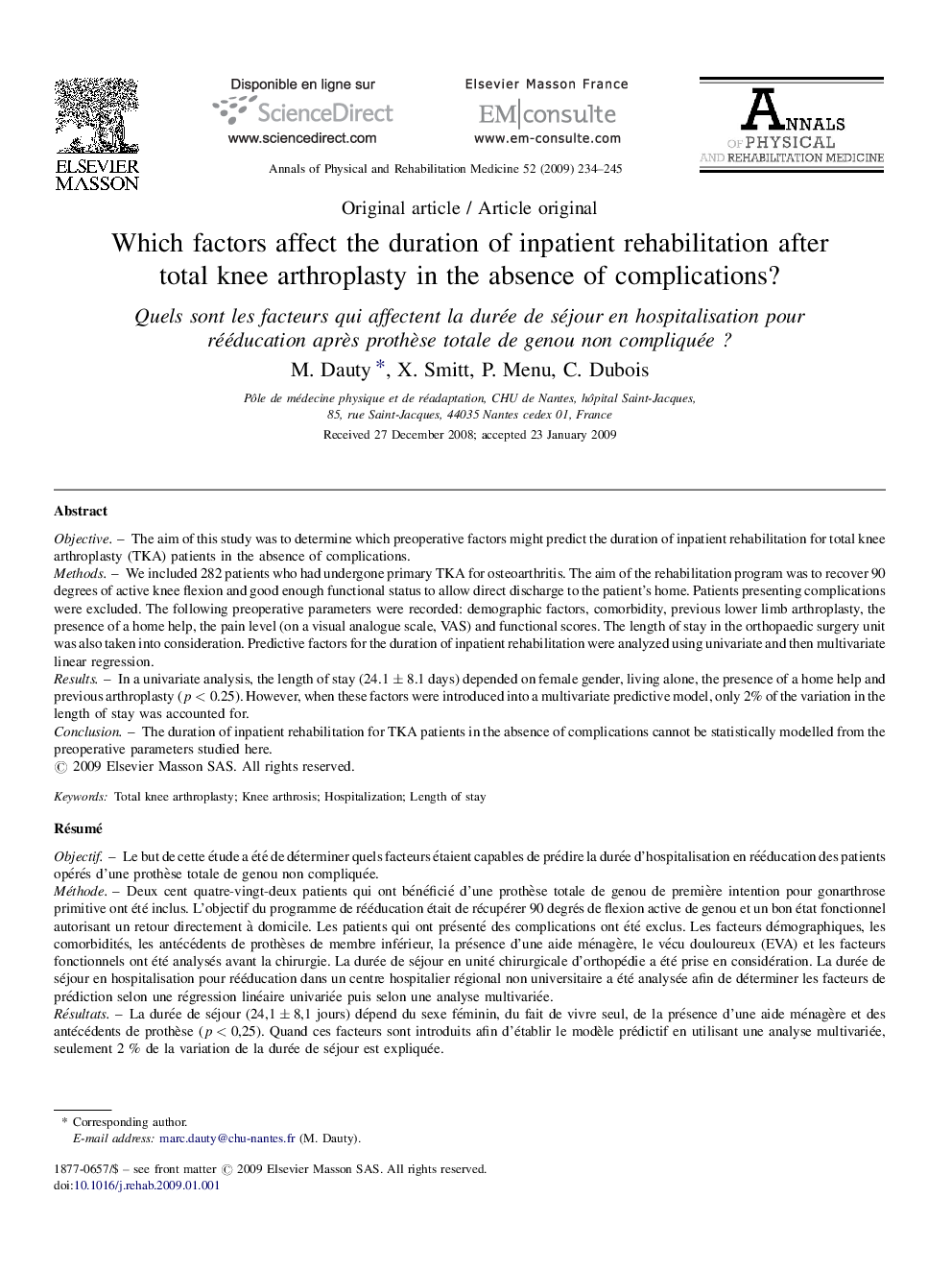| کد مقاله | کد نشریه | سال انتشار | مقاله انگلیسی | نسخه تمام متن |
|---|---|---|---|---|
| 4041425 | 1603358 | 2009 | 12 صفحه PDF | دانلود رایگان |

ObjectiveThe aim of this study was to determine which preoperative factors might predict the duration of inpatient rehabilitation for total knee arthroplasty (TKA) patients in the absence of complications.MethodsWe included 282 patients who had undergone primary TKA for osteoarthritis. The aim of the rehabilitation program was to recover 90 degrees of active knee flexion and good enough functional status to allow direct discharge to the patient's home. Patients presenting complications were excluded. The following preoperative parameters were recorded: demographic factors, comorbidity, previous lower limb arthroplasty, the presence of a home help, the pain level (on a visual analogue scale, VAS) and functional scores. The length of stay in the orthopaedic surgery unit was also taken into consideration. Predictive factors for the duration of inpatient rehabilitation were analyzed using univariate and then multivariate linear regression.ResultsIn a univariate analysis, the length of stay (24.1 ± 8.1 days) depended on female gender, living alone, the presence of a home help and previous arthroplasty (p < 0.25). However, when these factors were introduced into a multivariate predictive model, only 2% of the variation in the length of stay was accounted for.ConclusionThe duration of inpatient rehabilitation for TKA patients in the absence of complications cannot be statistically modelled from the preoperative parameters studied here.
RésuméObjectifLe but de cette étude a été de déterminer quels facteurs étaient capables de prédire la durée d’hospitalisation en rééducation des patients opérés d’une prothèse totale de genou non compliquée.MéthodeDeux cent quatre-vingt-deux patients qui ont bénéficié d’une prothèse totale de genou de première intention pour gonarthrose primitive ont été inclus. L’objectif du programme de rééducation était de récupérer 90 degrés de flexion active de genou et un bon état fonctionnel autorisant un retour directement à domicile. Les patients qui ont présenté des complications ont été exclus. Les facteurs démographiques, les comorbidités, les antécédents de prothèses de membre inférieur, la présence d’une aide ménagère, le vécu douloureux (EVA) et les facteurs fonctionnels ont été analysés avant la chirurgie. La durée de séjour en unité chirurgicale d’orthopédie a été prise en considération. La durée de séjour en hospitalisation pour rééducation dans un centre hospitalier régional non universitaire a été analysée afin de déterminer les facteurs de prédiction selon une régression linéaire univariée puis selon une analyse multivariée.RésultatsLa durée de séjour (24,1 ± 8,1 jours) dépend du sexe féminin, du fait de vivre seul, de la présence d’une aide ménagère et des antécédents de prothèse (p < 0,25). Quand ces facteurs sont introduits afin d’établir le modèle prédictif en utilisant une analyse multivariée, seulement 2 % de la variation de la durée de séjour est expliquée.ConclusionLa durée de séjour en hospitalisation pour rééducation après prothèse totale du genou non compliquée ne peut pas être modélisée statistiquement à partir des paramètres préopératoires étudiés.
Journal: Annals of Physical and Rehabilitation Medicine - Volume 52, Issue 3, April 2009, Pages 234–245